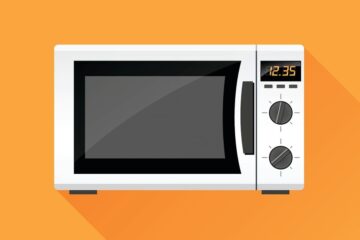Microwave ovens have become an indispensable part of modern-day kitchens. They offer a convenient way to reheat leftovers, cook frozen meals, and defrost food quickly. However, choosing the right size for a microwave oven can be a daunting task. In this article, we’ll take a look at the different sizes of microwave ovens and how to measure your space to ensure that you choose the right size for your needs.
The importance of choosing the right size for a microwave oven
Choosing the right size for a microwave oven is crucial for several reasons. Firstly, if you choose a microwave oven that’s too small, it may not fit all of the dishes that you want to cook. On the other hand, if you choose a microwave oven that’s too large, you’ll be wasting energy and money by heating up empty space. Secondly, a microwave oven that’s too big for your kitchen can make your kitchen feel cramped and cluttered.
Why measuring your space and knowing the different sizes available is essential?
Measuring your space and knowing the different sizes of microwave ovens available is essential to ensure that you choose the right size for your needs. By measuring your space, you’ll be able to determine the maximum size of the microwave oven that you can fit in your kitchen. Knowing the different sizes available will help you choose a microwave oven that’s the right size for your cooking needs.
Standard Sizes of Microwave Ovens
Microwave ovens come in four standard sizes: small, medium, large, and extra-large. Here are the dimensions, ideal users, and pros and cons of each size.
Small
Small microwave ovens are ideal for individuals or small families. They’re compact and take up minimal counter space.
Dimensions
Small microwave ovens typically have a capacity of less than 0.8 cubic feet and measure less than 18 inches in width, 12 inches in height, and 14 inches in depth.
Ideal for whom?
Small microwave ovens are ideal for individuals, students, or small families who don’t have much counter space and only need to cook small portions.
Pros and Cons
Pros
- Small and compact, taking up minimal counter space
- Energy-efficient
- Less expensive than larger microwave ovens
Cons
- Limited cooking space
- Not suitable for cooking larger portions of food
Medium
Medium microwave ovens are suitable for small to medium-sized families. They’re more spacious than small microwave ovens but still compact enough to fit on a kitchen counter.
Dimensions
Medium microwave ovens typically have a capacity of 0.8 to 1.2 cubic feet and measure between 18 and 21 inches in width, 12 to 14 inches in height, and 14 to 16 inches in depth.
Ideal for whom?
Medium microwave ovens are ideal for small to medium-sized families who need a little more space than a small microwave oven but still want a compact microwave oven that can fit on a kitchen counter.
Pros and Cons
Pros
- Spacious enough to cook small to medium-sized portions of food
- Compact and can fit on a kitchen counter
- Energy-efficient
Cons
- May not be suitable for larger families or for cooking larger portions of food
Large
Large microwave ovens are suitable for larger families or for those who frequently cook large portions of food. They’re more spacious than medium microwave ovens and are typically designed to be installed over a range or built into a cabinet.
Dimensions
Large microwave ovens typically have a capacity of 1.2 to 1.5 cubic feet and measure between 21 and 24 inches in width, 14 to 16 inches in height, and 16 to 20 inches in depth. It’s important to note that these dimensions may vary depending on the specific model and brand of the microwave oven.
Ideal for whom?
Large microwave ovens are suitable for larger families or for those who frequently cook large portions of food. They’re more spacious than medium microwave ovens and are typically designed to be installed over a range or built into a cabinet. If you have a large kitchen with ample space, a large microwave oven may be the best choice for you.
Pros and Cons
One of the main advantages of a large microwave oven is its spaciousness. It allows you to cook larger portions of food, which can save you time and effort in the kitchen. Additionally, some large microwave ovens come with advanced features like convection cooking, which can expand your cooking options and make meal preparation even easier.
On the other hand, the larger size of these microwaves means that they may take up more counter or cabinet space, which may be a drawback if you have limited space in your kitchen. They may also be more expensive than smaller models, which may be a concern for those on a tight budget.
Extra Large
Extra-large microwave ovens are the biggest type of microwave ovens available, and they’re designed for commercial use. These microwaves are typically used in restaurants, cafes, and other food service establishments.
Dimensions
Extra-large microwave ovens can have a capacity of up to 2.2 cubic feet and measure between 29 and 31 inches in width, 16 to 19 inches in height, and 22 to 24 inches in depth. These microwaves are typically designed to be installed in a commercial kitchen and may not be suitable for home use due to their large size.
Ideal for whom?
Extra-large microwave ovens are ideal for commercial kitchens where large quantities of food need to be prepared quickly. They can also be useful for home cooks who frequently entertain large groups or who need to cook large portions of food.
Pros and Cons
The main advantage of an extra-large microwave oven is its size. It allows you to cook large quantities of food quickly and efficiently, which can be a huge time-saver in a busy kitchen. Additionally, these microwaves may come with advanced features like multiple power levels and programmable cooking options, which can make meal preparation even easier.
However, the large size of these microwaves means that they may not be suitable for all kitchens. They may take up a lot of counter or cabinet space, and they may be more expensive than smaller models. Additionally, they may not be as energy-efficient as smaller microwaves, which may be a concern for some users.
Factors to Consider When Choosing a Microwave Oven Size
When choosing a microwave oven size, there are several factors to consider:
- Your available space: Measure the space where you plan to install your microwave oven and choose a size that will fit comfortably.
- Your cooking needs: Consider the types of food you typically cook and choose a microwave oven size that will accommodate your needs.
- Your budget: Larger microwave ovens tend to be more expensive than smaller models, so consider your budget when choosing a size.
How to Measure Your Space for a Microwave Oven?
To ensure that your microwave oven fits properly in your available space, follow these steps:
Measure the height, width, and depth of the space where you plan to install your microwave oven.
- Height: Measure from the countertop to the bottom of the cabinet or shelf above the space. Make sure to leave at least 1 inch of clearance space between the top of the microwave and the bottom of the cabinet or shelf.
- Width: Measure the width of the space from left to right. Make sure to factor in any obstacles or obstructions that may interfere with the installation.
- Depth: Measure the depth of the space from front to back. Make sure to leave at least 1 inch of clearance space behind the microwave.
Making sure to factor in clearance space
You’ll need at least 1 inch of clearance on all sides of the microwave to allow for proper ventilation and prevent overheating. This is especially important if you plan to install your microwave oven over a range or built into a cabinet.
Tips for ensuring a proper fit
If you’re unsure about the dimensions of the space or the clearance needed, it’s best to consult the manufacturer’s guidelines or seek the advice of a professional installer. Additionally, consider the shape of the space and the shape of the microwave oven. A square or rectangular microwave oven may be easier to install in a square or rectangular space, while an oval or rounded microwave oven may require more clearance.
Conclusion
In conclusion, choosing the right size for your microwave oven is important for both functionality and aesthetics. By measuring your available space and considering your cooking needs and budget, you can make an informed decision on which size to choose. Remember to factor in clearance space and consult the manufacturer’s guidelines or a professional installer if needed. With the right size and proper installation, your microwave oven can be a valuable addition to your kitchen appliances.



